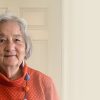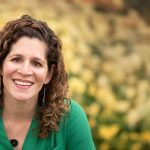Antwan Eady’s newest picture book, The Gathering Table (Knopf, 2025), illustrated by London Ladd, is a powerful recounting of a year of celebrations happening around one outdoor family table where food is shared alongside heaping helpings of love, hope, pride, and freedom. The book is packed full of affectionate and funny moments, resonating with readers on a universal level—celebrating all families and their traditions—while also serving as a heartfelt salute to a particular Black family. It resounds with the same kind of joy that placed Eady’s other picture books The Last Stand (illustrated by Jarrett & Jerome Pumphrey, Knopf, 2024) and Nigel and the Moon (illustrated by Gracey Zhang, HarperCollins, 2022) on multiple “Best Books of the Year” lists.
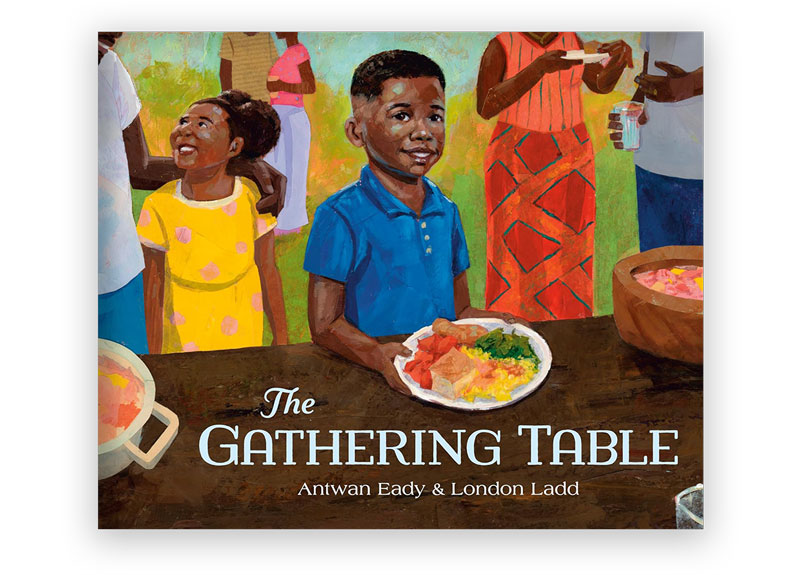
Here, Eady talks about celebrating his Gullah Geechee heritage, his hopes for today’s young dreamers, and the importance of “starting where you are.”
Will you share the inspiration for your newest picture book?
The Gathering Table was inspired by a special table in my life . . . from when I was a child to my teenage years, and it remains in my parents’ yard to this day. While it serves a different purpose now, it was once the table where we cleaned fish after a day of fishing; it’s where we’d dump our Low Country boils (aka seafood boils) before diving in to eat; it’s where memories were made. But as our family grew and others (aunts, uncles, neighbors) gathered around the table, my dad eventually built newer, larger tables for us to gather/stand around.
The Gathering Table highlights the kinds of relationships that are created when a family of Gullah Geechee heritage gathers to celebrate love, hope, pride, and freedom. As seasons change, a young dreamer assists his family at each gathering. Here, he works, he waits, and he eats. The table is where younger generations learn as knowledge of their culture is passed down through actions, storytelling, games, song, and laughter. With a backdrop of marshes, Spanish moss, and more, The Gathering Table pays homage to the sea islands of South Carolina and Georgia (aka the Low Country), an area predominantly inhabited by descendants of enslaved West Africans, known today as the Gullah Geechee Corridor.
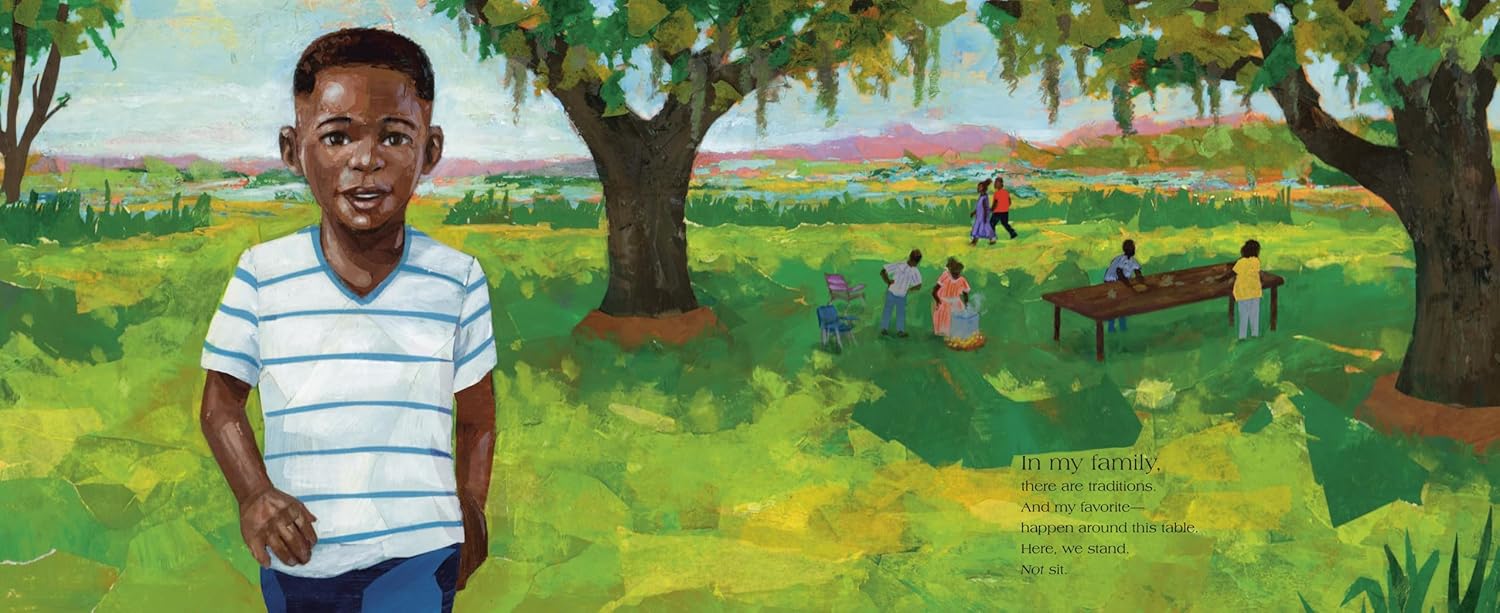
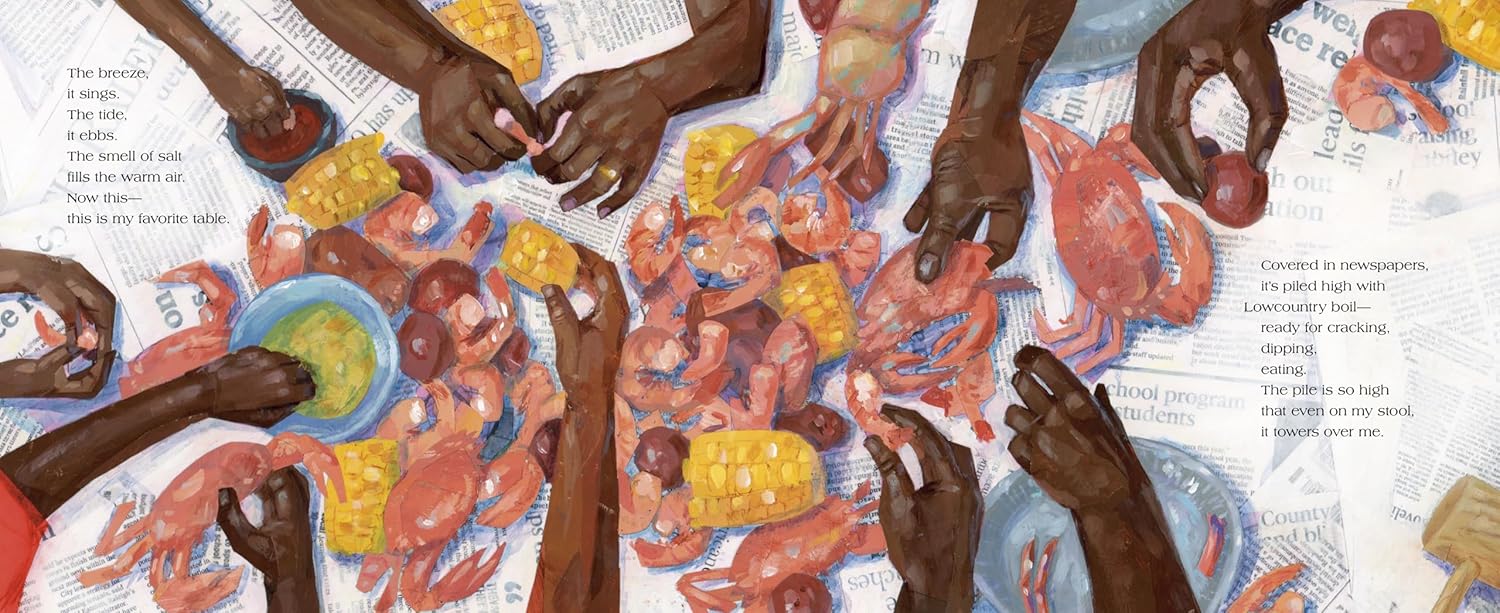
As I studied the book, it evoked the idea that each of us is shaped by a foundation of family, community, and shared traditions—and it is that foundation that helps us grow into ourselves and our dreams. Would you like to say more about that?
I’m preserving our culture through literature in a way that hasn’t been done in the traditional publishing space (in children’s literature). Just a few years ago, the first Gullah Geechee cookbook was published and went on to become a New York Times bestseller. So, there aren’t a lot of “us” in the traditional space yet, but in recent years, there’s been a surge of putting Gullah Geechee pride on full display, and it’s been wonderful!
Overall, I want to pay homage to my family. My maternal and paternal grandparents are deceased . . . as are my parents. Telling our story and sharing our joy are my ways of honoring all of them; of sharing their beauty with others.
I’m preserving our culture through literature in a way that hasn’t been done in the traditional publishing space (in children’s literature).”
What recommendations do you have for students who are interested in sharing stories about their own family and community traditions?
Jacqueline Woodson wrote, “There will be times when you walk into a room and no one there is quite like you.” This is from The Day You Begin (one of my favorite picture books). So, to young dreamers, don’t be afraid to share. Often, we discover that we’re more alike than different.
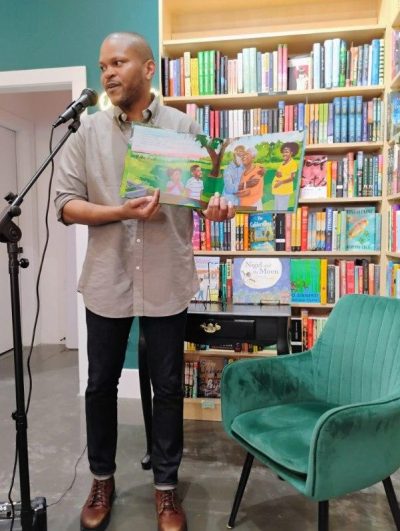
Elements of the natural world wind their way through The Gathering Table, echoing back and forth with the people who have established roots in this special place: Spanish moss, long and gray, drapes from above. Grandpa’s beard, long and gray, drapes from below. How did you manage to bring the setting in the book to such glorious life through your words while still allowing your illustrator, London Ladd, to fully use his imagination to create the artwork?
In London’s words, “Antwan suggested places I could explore to see, feel, smell, and hear the environment while researching The Gathering Table. At the Pin Point Heritage Museum in Savannah, Georgia, the warmth and vibrancy of the beautiful, lush greens surrounding the area deeply affected me, and I wanted to convey that feeling.”
And convey that feeling he did! London traveled to our beautiful southern coast and immersed himself in the environment.
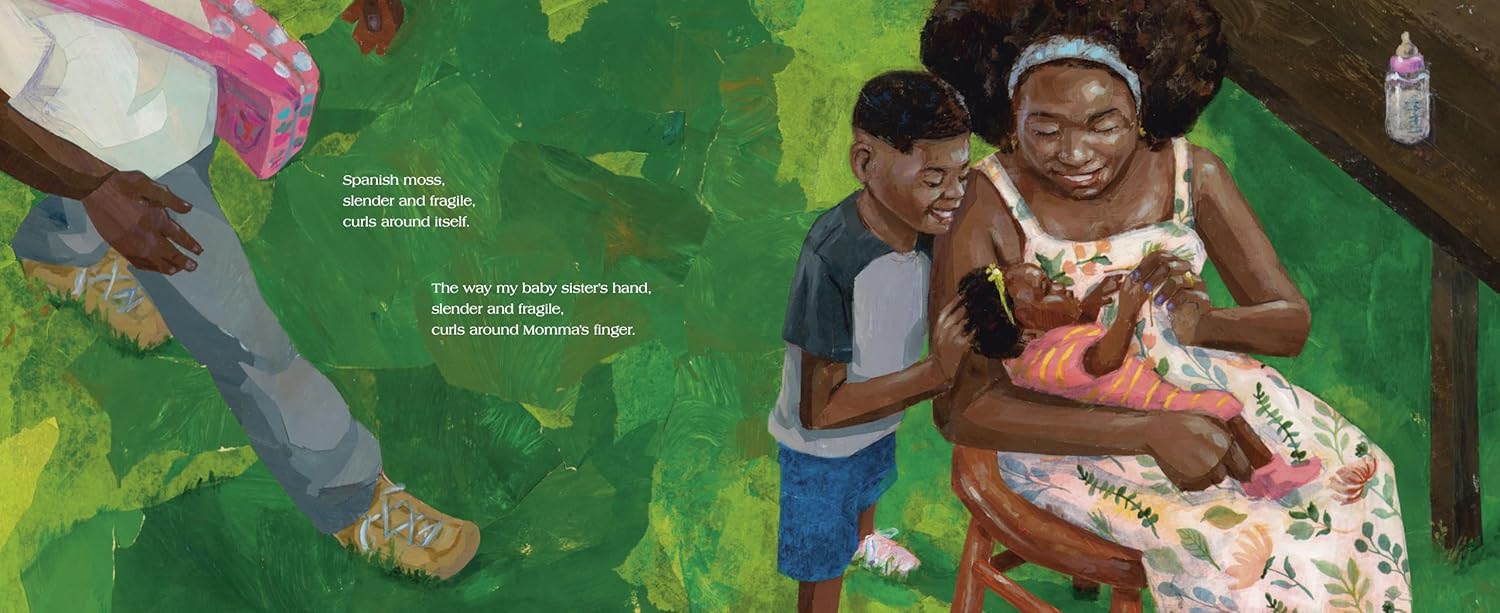
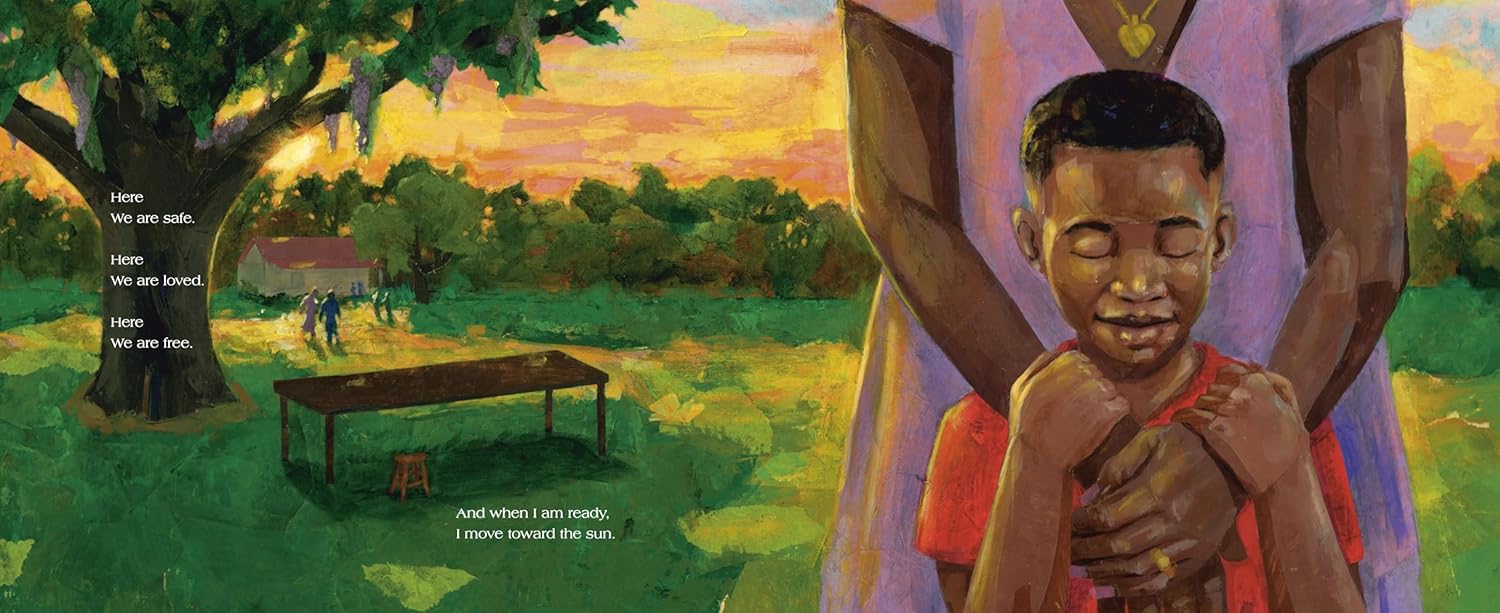
What advice do you have for students who are hoping to write about a place that has personal power for them?
This setting means everything to me because it’s home, and I always want to do it justice when sharing it with the world. For young dreamers hoping to do the same, look back at photographs, speak with relatives (especially the elders in your lives), and do what London did, immerse yourself in that space—in a safe manner, of course.
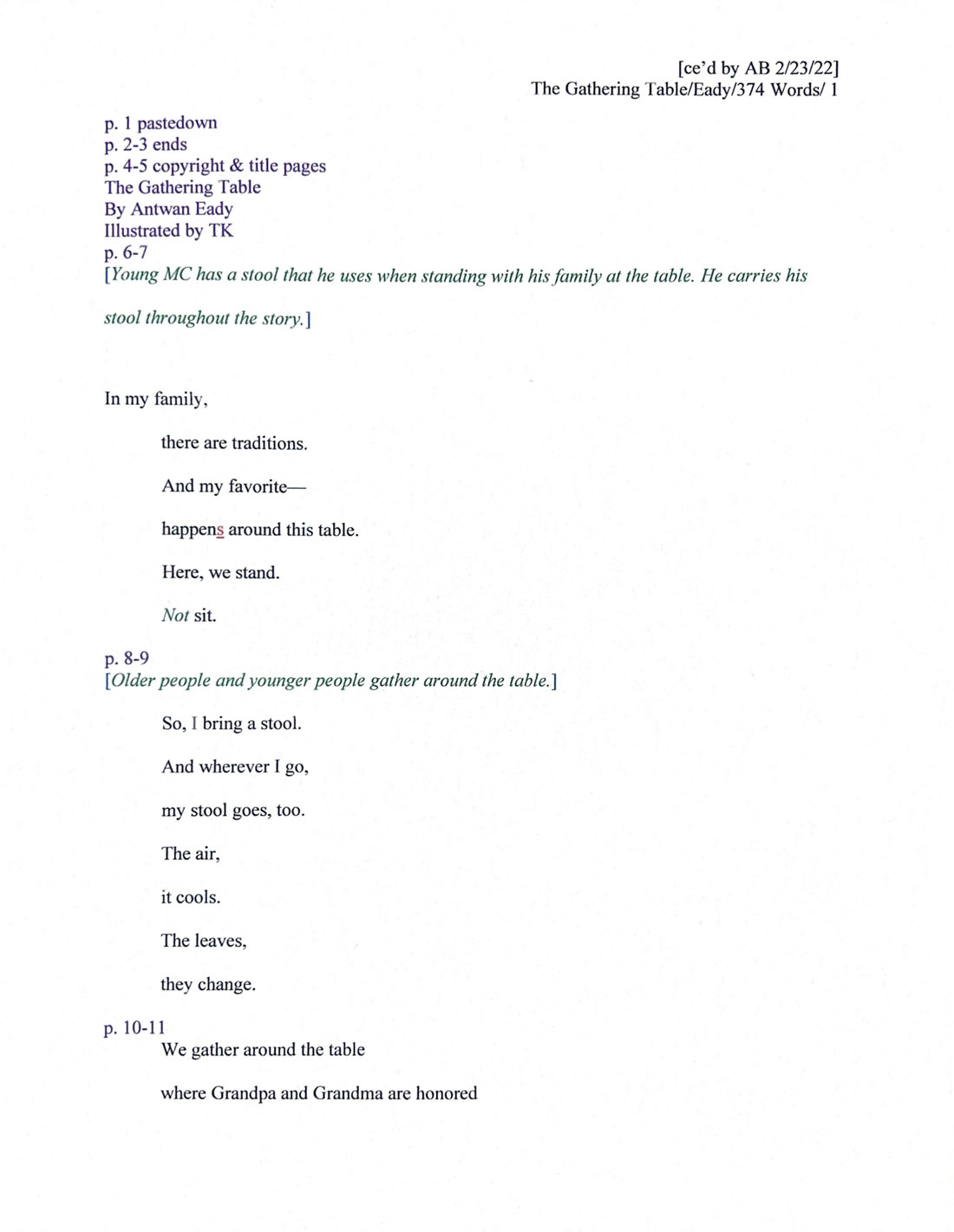
Copy edits for The Gathering Table
What do you hope The Gathering Table will inspire in young dreamers?
Young dreamers are torchbearers in the making. They’re the ones who will carry customs and traditions as so many have done before them. I trust young dreamers and believe they’re able to take stock of the world around them just as our narrator does in The Gathering Table. Yes, the table is filled with food and fun, but there’s so much that goes beyond the surface. I implore young dreamers to discover and observe those tiny, beautiful things, especially while they have them.
Young dreamers are torchbearers in the making. They’re the ones who will carry customs and traditions as so many have done before them.”
I was as a young dreamer. I grew up in Garnett, South Carolina. And down the dirt roads of South Carolina, I would stare at the moon every night. I would sit on my parents’ porch, and with my telescope, I would pretend to be everything that I wanted to be. And I was able to dream big. It’s fitting that my debut picture book, Nigel and the Moon, is about a young boy who’s afraid to tell the world his dreams, so he shares them with the moon at night.
So, young dreamers, where you are now isn’t where you’ll always be. Let your dreams carry you . . . protect those dreams and cherish them.
Young dreamers, where you are now isn’t where you’ll always be. Let your dreams carry you . . . protect those dreams and cherish them.”

What else would you like to say to young people who have big dreams?
Start where you are. I say this often because it’s true.
Sometimes you must start where you are. As a writer, I stood in my own way for so many years. A decade really. I wrote my first picture book in 2007. I started a novel in 2011. I wrote poetry all my life but stopped in 2011 or 2012.
I was waiting for the “perfect” environment. The “perfect” desk. A new laptop, etc.
But one day, instead of focusing on what I didn’t have or what I didn’t know, I got started. Without a writer’s desk. On an ancient laptop that was given to me (one that couldn’t hold a charge and had to be plugged in to work). So, young dreamers, start where you are.
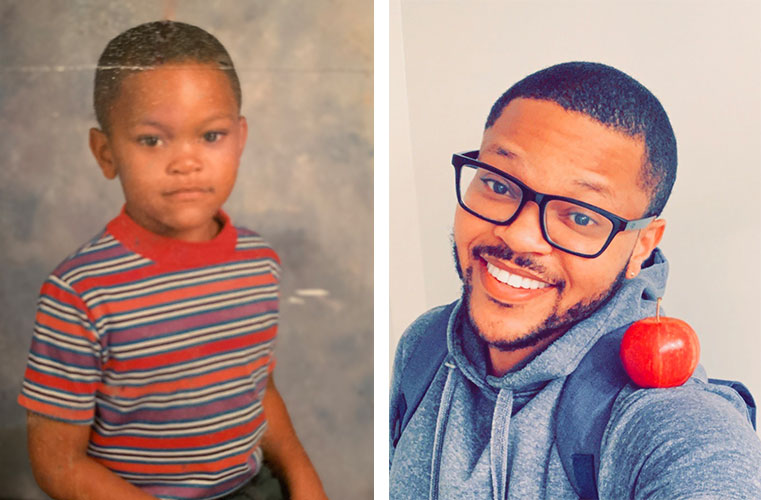
What’s your favorite part of creating books for young readers?
Young readers are young dreamers, including those who haven’t discovered their favorite books yet. My favorite part of this journey is meeting young dreamers around the world. Hearing their questions, showing them pictures from my career in animal medicine, and just receiving their joy and brilliance.
Young readers are young dreamers, including those who haven’t discovered their favorite books yet. My favorite part of this journey is meeting young dreamers around the world.”
Are there particular resources for The Gathering Table that you’d like to recommend to educators?
Teaching Books offers so much regarding the book. I encourage everyone to check it out.
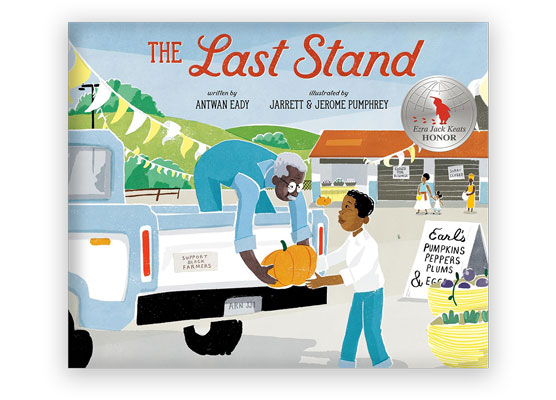
Can you share any details about your forthcoming books?
Yes! I have several projects at different stages of production. We recently announced two picture books! Tears Are for You is a picture book ode to the vulnerability of Black children, especially Black boys, set one summer in the South as one child reconnects with his family’s roots and discovers his tears reflected in the world around him.
Like Grandma’s sweet tea / welcoming you down south / Like long-awaited rain / peppering Grandpa’s still-thirsty crops / Like [insert lines I won’t give away] / tears are for you, too.
I’m collaborating with Jamiel Law (@jamiellaw_art) on this one, and I’m thrilled he said yes!
Also in that announcement, we shared information on another picture book: People of the Coast! This one’s a literary celebration of Gullah Geechee culture.
We . . . are place—
Playful / where mud becomes pie.
Nurturing / where seed becomes crop.
Peaceful / where day becomes night
and stars dress the sky.
Some . . . call us Gullah.
Others . . . call us Geechee.
And to a few . . . we’re Gullah-Geechee.
But do you know who we are?
For this, I’m honored to work with Cozbi A. Cabrera (@cozbi)! I’m a huge fan of her illustrations.
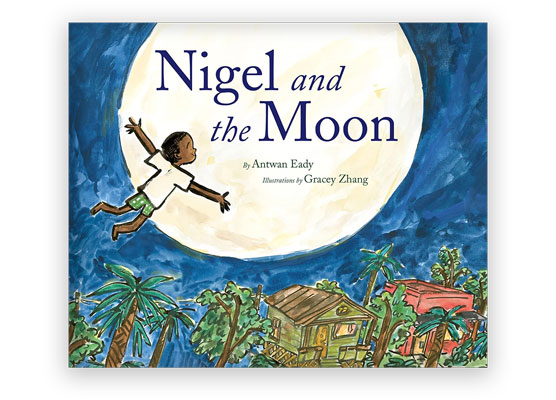
What are the best ways for educators and librarians to connect with you or to follow you on social media?
Educators and librarians can connect with me on social media. I’m most active on Instagram (@antwan.eady). I have a website as well, so please reach out through my contact page. It includes information on how to request school visits and more.
Letters from readers can be sent to:
Writers House
c/o Antwan Eady
7660 Fay Ave #338H
La Jolla, CA 92037
Activities for The Gathering Table can be found here.



